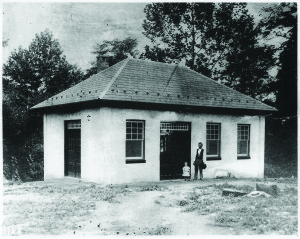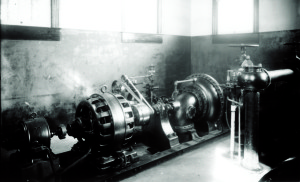by James Rada, Jr.
1908 — Let There Be Light
Thomas Edison invented the light bulb in 1879, and soon thereafter, companies began forming to provide electricity and light to homes and communities. Larger cities were the first recipients, but eventually, it became a feasible project for smaller communities.
However, as community after community turned on their lights, Thurmont remained in the dark.
A small blurb in a 1907 Catoctin Clarion read, “Rumor has it that certain parties have been in town this week looking up the question of installing an electric lighting plant, who knows anything about the fact in this matter? Assuredly we will not get anything better until some strangers come to town and start the ball rolling, for it seems that we don’t have enough enterprising spirit in town to have anything other than what we have now, which is next to no light at all. Come on Mr. Man whoever you may be, the field is yours, with no competitor but the Moon.”
Although the town of Thurmont had no authority under its charter to build an electric lighting plant, some local citizens did decide to step up to the challenge. Peter Hammaker, Charles Mackley, Lester Birely, and Morris Birely created The Citizens’ Electric Light and Power Company of Thurmont. Working with the town government, the company made plans for bringing electricity to the town.
However, as the company began purchasing rights of way that were needed to run the plant, it ran into some problems. A right of way was needed to bring the water from Hunting Creek to the turbine wheel to generate the power. Two landowners decided to try and gouge the company, asking three times as much as the right of way was worth.
Eventually, they were convinced to sell the right of ways, but a second problem wasn’t so easily addressed. As the project to use the water from Hunting Creek to power Thurmont started, the creek entered a drought period and the water flow began falling off. Questions were raised as to whether the plant would be able to deliver on its promises.
An article in the Catoctin Clarion noted, “I think all will agree that the present drought is unprecedented, except perhaps last year.” The article then went on to explain that it was estimated that 102 horsepower hours was needed each day to light the town. Even at the lower water flow, not only could the town’s lighting needs be met, but “We will still have 163 horsepower hours for commercial purposes or day load, even at the small flow of the stream,” the newspaper reported.
The project went forward, and citizens of the town could purchase stock in the company in $100 shares (about $3,100 in 2015). Although expensive, the idea was to keep the money in town. Local stockholders would own the company and the company would in turn power the town where the stockholders lived. In addition, it was expected that the town would eventually take over the company and the stock would be exchanged for municipal bonds that paid five percent interest annually.
The Clarion, which had been an early supporter of the plant turned against it for this reason. The editors saw that even though the bonds were a good deal for the stockholders, it was believed that the cost of paying off those bonds would require an increase in town taxes. The newspaper reported, “the town is about to take a step that will mean a burden to its people for the next twenty years in attempting to get a lighting system that will prove a most costly experiment to the town.” The newspaper projected that taxes would jump from 30 cents per $100 to at least 80 cents.
This fear did not come to be, and the plant was built. It began furnishing power to the town.
During the 1910 legislative session, Thurmont commissioners asked for and received the authority needed to allow the town to run and maintain an electric plant. It also received the authority to buy the existing plant and to pay the stockholders with municipal bonds.
The following year’s budget showed that the entire cost of the purchase of the plant (not including annual interest payments) amounted to $21,100.83, and the annual operating expense was $1,074.40. The town also maintained a separate light bulb account of $628.17 to sell light bulbs to residents who needed them once their homes and businesses were wired for power.
The plant served Thurmont for fifteen years, but then because of town growth and intermittent dry periods for Hunting Creek, Thurmont had to start buying current from Potomac Edison until a new power system was constructed.
The outside of the old Thurmont Electric Power Plant.

Pictured is the generator that was located on the inside of the old Thurmont Electric Power Plant.


